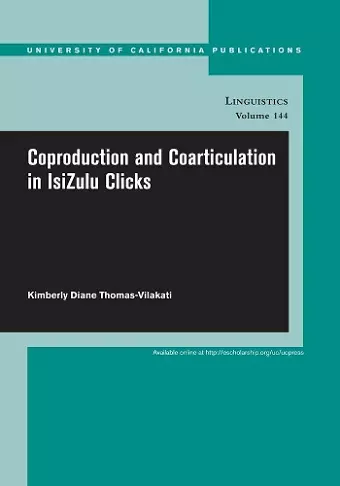Coproduction and Coarticulation in IsiZulu Clicks
Kimberly Thomas-Vilakati author
Format:Paperback
Publisher:University of California Press
Published:6th Jul '10
Should be back in stock very soon

This book provides an in-depth look at the production of clicks using a variety of different techniques. Static palatography, linguography, electropalatography, and aerodynamic data, including the intra-oral pressure of the click cavity, never previously before measured, all combine to create a comprehensive picture of click consonants. This important work provides conclusive evidence that click consonants co-articulate, or adjust their articulation, with adjacent consonants in interesting ways. Although clicks are widely considered to be among the most interesting classes of segments, many aspects of their phonetics are little known. This book examines how the three different click types of IsiZulu differ from each other in their production in both spatial and temporal dimensions, and considers the question of how these complex segments are integrated into the stream of speech. Strong claims have been made in the literature that clicks do not coarticulate, but there is little articulatory evidence to support this claim. Coproduction and coarticulation of the dental, palato-alveolar and lateral clicks of IsiZulu were examined using three different techniques for the collection of physiological phonetic information: staticpalatography and linguography, dynamic palatography, and aerodynamic records. Four native IsiZulu speakers provided controlled data sets of real IsiZulu words. Results indicate that the characteristics of the front closure release are markedly different for the three click types. Rarefaction in all three click types is achieved by lowering the tongue center, with the greatest proportional change in cavity volume occuring in palato-alveolar clicks and the least with laterals. Palato-alveolar clicks supplement tongue center lowering with some retraction of the location of the dorsal closure. Quite extensive adaptation of both spatial and timing properties of clicks to the different vowel contexts is observed. For example, the dorsal closure is fronted in front vowel contexts, and before mid vowels the tongue center rises in preparation for the upcoming mid-vowel. Clicks are indeed complex articulations but they none-the-less coarticulate. This book contains a wealth of physiological phonetic data, including aerodynamic measures of the click cavity, which have never before been measured, and provides us with a comprehensive account of click consonants.
ISBN: 9780520098763
Dimensions: 254mm x 178mm x 13mm
Weight: 454g
258 pages